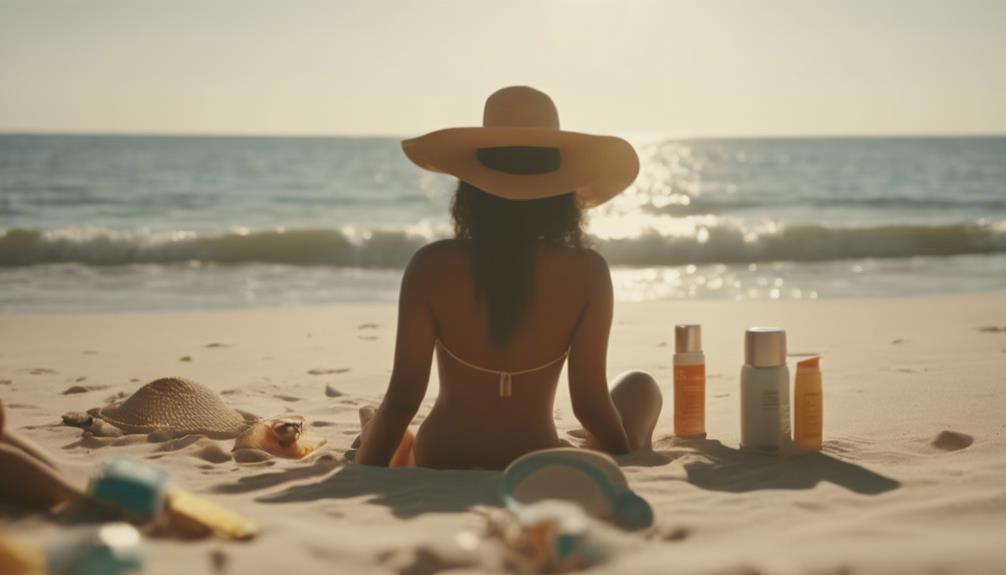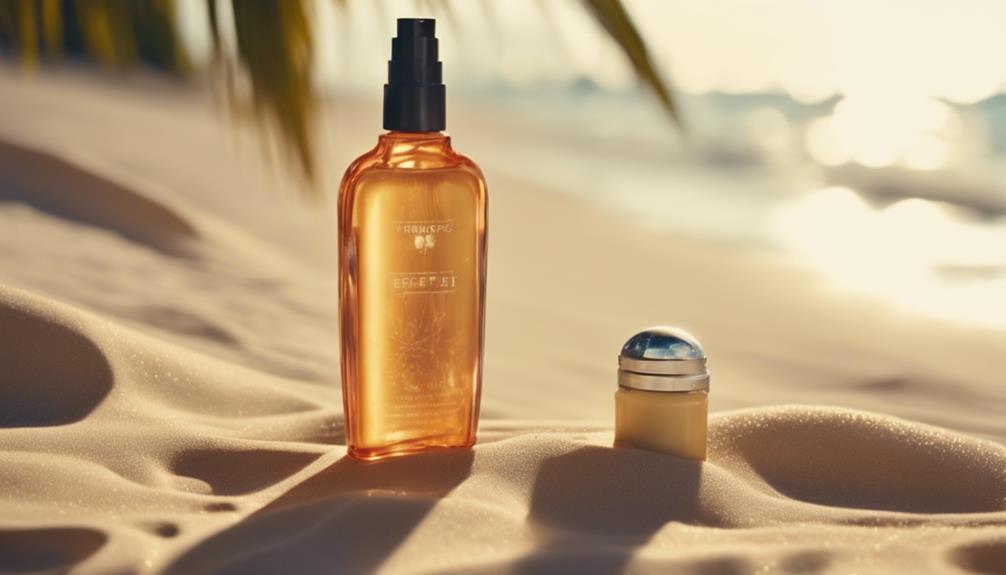To choose the right sunscreen for tanning, pick one with at least SPF 30 for fair skin, and higher SPF if you have darker skin or plan extended sun exposure. Opt for broad-spectrum protection to shield against UVA and UVB rays. Mineral sunscreens like zinc oxide are gentle and reflect UV rays, ideal for safer tanning. Remember to apply generously, reapply every two hours, and consider environmental factors. Keep exploring other tips to maximize your sun safety and glow effectively.
Key Takeaways
- Select a broad-spectrum sunscreen that protects against both UVA and UVB rays for effective tanning safety.
- Use at least SPF 30, increasing to SPF 50 for extended outdoor or sensitive skin exposure.
- Choose physical/mineral sunscreens with zinc oxide or titanium dioxide for gentle, reef-safe protection.
- Consider your skin type and tanning goals; darker skin may tolerate lower SPF, while fair skin needs higher protection.
- Reapply sunscreen every two hours, especially after swimming or sweating, to maintain effective coverage.
Understanding Tanning and Sunscreen Basics

Understanding how tanning works and the basics of sunscreen is essential for effective skin protection. When exposed to UV rays, your skin produces melanin to shield itself from damage. UVA rays penetrate deeply, contributing to tanning and skin aging, while UVB rays cause sunburn and help your body produce vitamin D. SPF measures protection against UVB, but a broad-spectrum sunscreen defends against both UVA and UVB. A common misconception is that a “base tan” offers significant protection—it’s minimal, equivalent to SPF 3. Remember, cumulative UV exposure raises your risk of skin cancer, including melanoma. Physical sunscreens with zinc oxide or titanium dioxide reflect UV rays, while chemical ones absorb them. Always reapply every two hours, especially when swimming or sweating, to maintain protection. Broad-spectrum protection is crucial for comprehensive skin defense against the full range of UV radiation. Additionally, choosing a sunscreen appropriate for your skin type can improve comfort and effectiveness during prolonged outdoor activities. It is also important to be aware that proper application techniques can significantly enhance the effectiveness of your sunscreen.
Selecting the Appropriate SPF Level for Your Skin Type
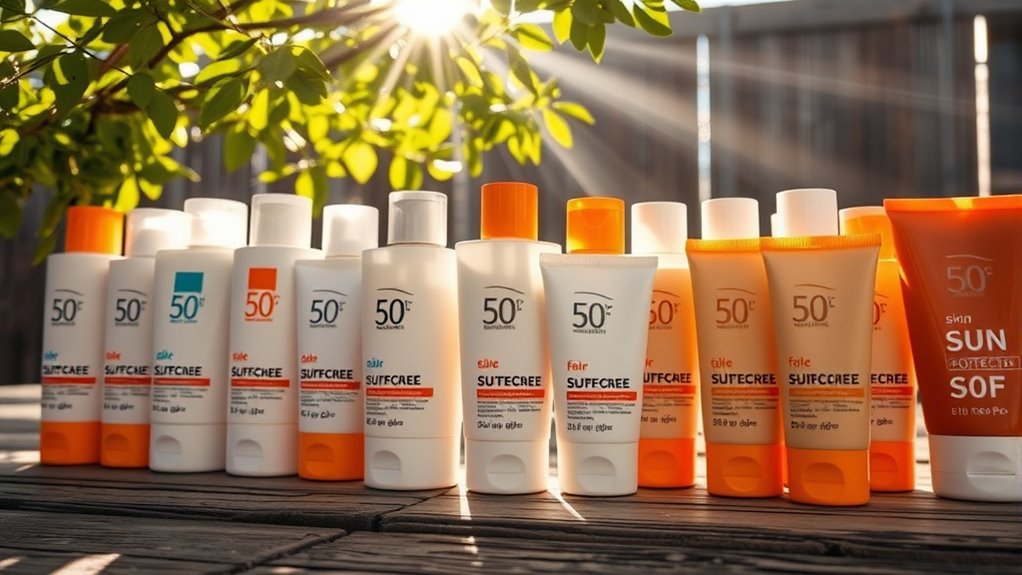
Choosing the right SPF level depends heavily on your skin type and how your skin reacts to sun exposure. If you have fair skin, you should opt for at least SPF 30 because you burn more easily. For extended outdoor time, SPF 50 offers extra protection, but reapplication is essential. Darker skin types can usually tolerate more sun, so SPF 20 or 25 might suffice, though higher SPFs are advisable for prolonged exposure. Sensitive skin benefits from higher SPF sunscreens to reduce irritation. Remember, no matter your skin type, broad-spectrum protection is vital to guard against UVA and UVB rays. Regular reapplication and combining sunscreen with protective clothing add extra layers of defense, helping you enjoy the sun safely without risking damage or premature aging. Sun protection is essential for maintaining healthy skin and preventing long-term damage. Incorporating proper application techniques ensures maximum effectiveness of your sunscreen. Additionally, choosing sunscreens with appropriate SPF levels tailored to your skin type can significantly improve protection and skin health. Using sunscreens formulated with gentle, hypoallergenic ingredients can also benefit those with sensitive skin. To optimize your sun safety strategy, understanding how UV radiation impacts your skin can guide better protection choices.
Exploring Different Types of Sunscreens for Tanning
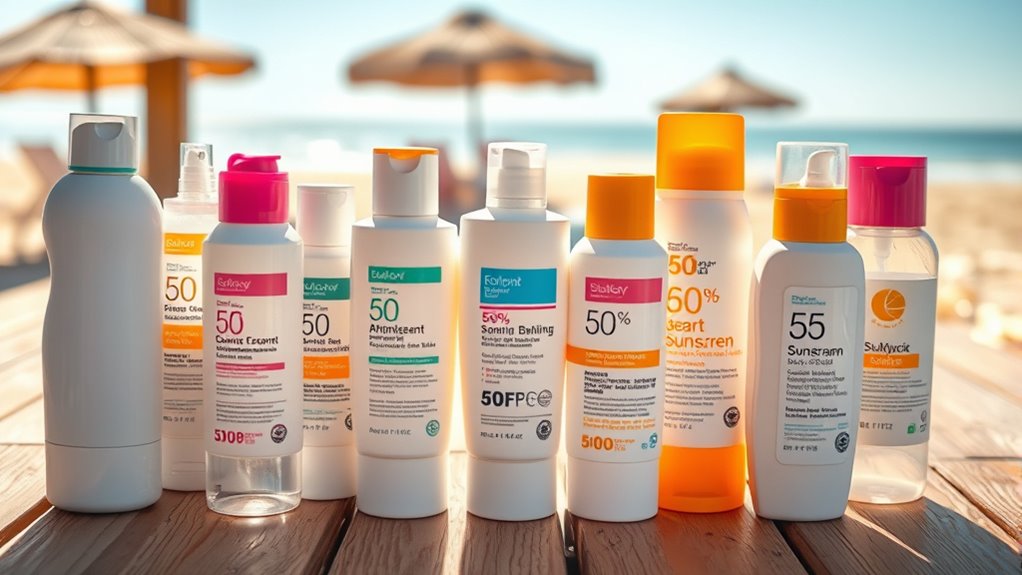
When selecting a sunscreen for tanning, it’s important to contemplate the different types available to find one that matches your desired level of protection and glow. Chemical sunscreens absorb UV rays, converting them into heat, allowing some tanning while providing moderate protection. They’re easy to apply and often less visible on your skin. Physical or mineral sunscreens reflect UV rays away from your skin using ingredients like zinc oxide and titanium dioxide, offering broader and stronger protection—ideal if you want to minimize damage and still tan. Tanning oils combine nourishing ingredients with UVA and UVB filters, enhancing hydration and giving a sun-kissed look while resisting water. Additionally, understanding the importance of climate control in outdoor environments can help optimize your tanning experience and protect your skin effectively. Recognizing the benefits of self-sufficiency in your sun protection routine can further ensure you stay safe during extended outdoor exposure. Incorporating data analytics to monitor UV exposure levels can also help tailor your sun protection strategy more effectively. Using water-resistant formulations can provide better protection during outdoor activities involving water or sweating. For example, some sunscreens include broad-spectrum protection to safeguard against both UVA and UVB rays, which is crucial for comprehensive skin safety. Ultimately, tanning-specific sunscreens with bronzing agents provide immediate color and boost melanin production, perfect for achieving a faster, more vibrant tan.
Key Ingredients to Look for in Tanning Sunscreens

Selecting the right tanning sunscreen involves paying close attention to its key ingredients, which directly influence its protective and tanning properties. Look for mineral filters like zinc oxide and titanium dioxide, which provide broad-spectrum protection by reflecting UV rays, and are gentle on sensitive skin. Incorporate chemical filters like avobenzone and octocrylene to enhance UVA and UVB absorption and improve water resistance. Avoid ingredients like oxybenzone and octinoxate due to skin absorption concerns and environmental impact. For skin nourishment, choose sunscreens with moisturizing agents such as shea butter, aloe vera, and glycerin, which keep your skin hydrated and comfortable. Additionally, ingredients like copper peptides and fruit extracts can promote melanin production and healthy tanning. Always verify that harmful components, such as parabens or fragrances, are absent. safety considerations in your selection process ensure you choose a product that offers effective protection without adverse effects. Moreover, considering advancements in skin-friendly formulations can further enhance your tanning experience while maintaining skin health. Incorporating proper storage methods, such as keeping sunscreen in a cool, dry place, can also help preserve its efficacy over time. Regularly checking for air quality concerns can help you choose products that are better suited for sensitive skin environments, especially if you suffer from allergies or respiratory issues. Staying informed about testing and certification standards can help ensure the product’s safety and quality before use.
Safe Practices for Tanning With Sunscreen

Using the right sunscreen is just one part of safe tanning practices. To protect your skin, reapply sunscreen every two hours, especially if you’re swimming or sweating. Choose water-resistant formulas when in water to maintain protection. Remember, sunscreen doesn’t block all UV rays, so seek shade during peak hours from 10 a.m. to 2 p.m. and wear protective clothing with UPF ratings. Avoid prolonged sun exposure without additional safeguards. Stay hydrated and regularly check your skin for signs of damage or early skin cancer. While sunscreen reduces risk, it doesn’t eliminate it entirely. Combining sunscreen with other protective measures, such as hats and sunglasses, maximizes your safety. Proper skin protection can also prevent damage caused by sun exposure, so consider using hair products formulated for sun protection as part of your routine. Additionally, understanding UV radiation levels can help you plan safer tanning sessions. Being aware of UV index forecasts can further help you determine the safest times to be outdoors. Monitoring sun safety guidelines and behaviors is essential for enjoying tanning responsibly and minimizing long-term skin damage.
Considering Environmental Impact When Choosing Sunscreen
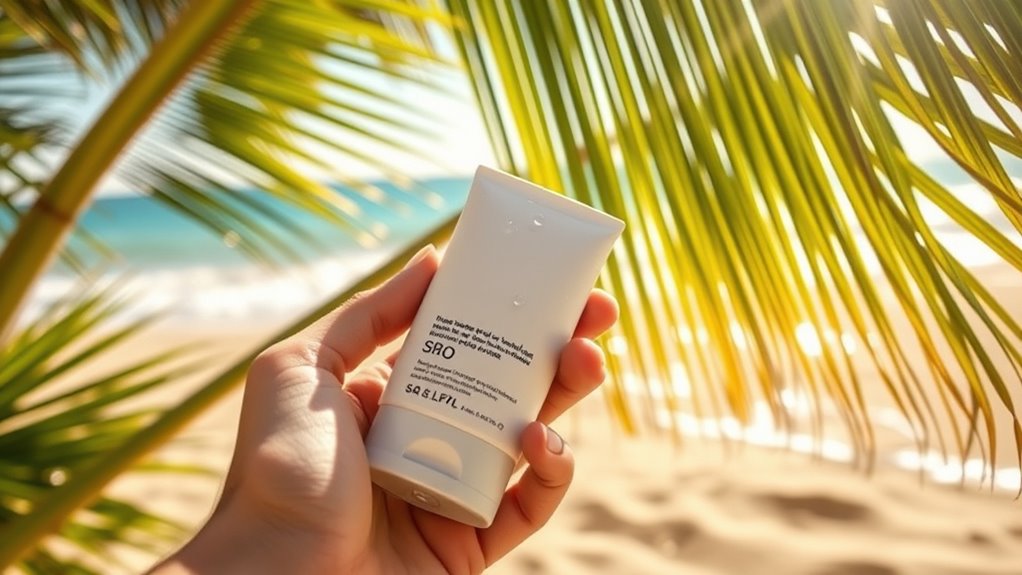
Considering the environmental impact of your sunscreen choices is essential to protect marine ecosystems, especially coral reefs. Chemical UV filters like oxybenzone are highly toxic to corals, causing bleaching and DNA damage, which threaten reef health and local livelihoods. About 25% of applied sunscreen washes off during swimming, entering oceans directly, while wastewater from showers and laundry also carries these chemicals. Many treatment plants don’t fully remove UV filters, allowing contamination to persist. To minimize harm, opt for mineral-based sunscreens with zinc oxide or titanium dioxide, which are less damaging to reefs. Additionally, choose reef-safe products that avoid oxybenzone and octinoxate. Using UV-protective clothing or seeking shade reduces sunscreen use altogether, helping preserve marine life while enjoying your time in the sun. Understanding how UV filters behave in water can further inform your choices to protect both your skin and the environment, especially considering the behavior of chemical filters in aquatic environments.
Tips for Applying Sunscreen Effectively During Tanning

To achieve a safe and even tan, it’s essential to apply sunscreen properly during your sunbathing sessions. Start by applying it 20-30 minutes before sun exposure to give it time to absorb and offer full protection. Reapply every two hours, or every 40 minutes if you’re swimming or sweating, to maintain effective coverage. Use at least one ounce of sunscreen to cover your entire body, including ears, neck, and feet, ensuring no spots are missed. Apply in smooth, even strokes without rubbing off the previous layer. After towel drying or heavy sweating, reapply to keep protection intact. Avoid waiting too long after sun exposure begins to prevent early UV damage, and layer generously for ideal sun safety.
Frequently Asked Questions
Can I Still Get a Tan With High SPF Sunscreen?
Yes, you can still get a tan with high SPF sunscreen. It filters out many UV rays but doesn’t block all, so some rays penetrate your skin and stimulate melanin production. The higher the SPF, the more protection you get, but a slight tan is still possible. Remember, tanning still carries skin damage risks, so reapply often and limit sun exposure for healthier skin.
How Long Does Sunscreen Protection Last During Tanning?
Sunscreen protection during tanning typically lasts about 2 hours before you need to reapply. Factors like sweating, swimming, and skin coverage affect this duration. Even with high SPF, your protection diminishes over time, especially under intense sunlight. To stay protected, reapply every 2 hours, or immediately after water or sweating. Keep in mind, no sunscreen offers complete protection, so limit your sun exposure and seek shade when possible.
Is It Safe to Use Tanning Oils With SPF?
Using tanning oils with SPF isn’t completely safe, but it’s better than using oils without protection. Tanning oils with SPF can help block some UV rays, reducing your risk of skin damage, but they shouldn’t be your only protection. Always combine them with broad-spectrum sunscreen and limit your sun exposure. Remember, no product can fully prevent sun damage, so take extra precautions like seeking shade and avoiding peak hours.
Should I Choose Mineral or Chemical Sunscreen for Tanning?
When choosing between mineral and chemical sunscreen for tanning, consider your skin type and preference. Mineral sunscreens reflect UV rays and are gentler, making them ideal if you have sensitive skin or want immediate protection. Chemical sunscreens absorb UV rays, often feeling lighter and more transparent. Both protect against UV damage effectively, but proper application and reapplication are key. Pick the one that suits your skin and comfort for a safer tanning experience.
How Does SPF Affect the Speed of Tanning?
Think of SPF as a dimmer switch for sunlight—higher SPF dims the UV rays reaching your skin. With a higher SPF, you slow down your tanning process by blocking more UVB rays, which produce melanin. While UVA rays still promote tanning, a high SPF extends your time in the sun safely. So, if you want a gradual tan, opt for a higher SPF, but remember, it’s about balancing protection and exposure.
Conclusion
Choosing the right sunscreen makes your tanning safer and more enjoyable. Did you know that applying sunscreen properly can reduce your risk of skin damage by up to 90%? By understanding your skin type, selecting the right SPF, and using effective application techniques, you can achieve a beautiful tan while protecting your skin. Remember, environmentally friendly options matter too—so pick sunscreens that shield your skin and the planet. Stay safe and sun-smart!


